September 06, 2024
Protecting Data Security in Digital Surveillance Equipment
Growing demand for advanced digital surveillance solutions is accompanied by an increasing diversity of deployment scenarios, including outdoor, body-mounted, and mobile cameras. Embedded storage, such as boot drive built into cameras and associated monitoring equipment must combine enhanced ruggedness to withstand environmental conditions such as shock, vibration, extreme temperatures, and humidity, with advanced features to protect data integrity.

The Ferri embedded storage portfolio offers a broad selection of device types, covering low- to high-density options, with Silicon Motion's advanced and proprietary technologies to provide whole-life protection for sensitive data.
Background: Market Demand for Advanced Digital Surveillance Equipment:
In today's world, governments, enterprises, and individuals place a high value on safety and security, which is fueling demand for digital surveillance equipment. On the other hand, equipment such as cameras continue to become more sophisticated and affordable, supporting advanced capabilities such as mobile surveillance and image analytics. Together, these factors create perfect conditions for growth. The global market for surveillance cameras is increasing at more than 8% (CAGR) and is expected to exceed $39 billion by 2025.
Key drivers of demand include ongoing deployments at street level as urban populations continue to grow and expect authorities to provide protection. Governments also rely on surveillance information to monitor and contain terror threats. Private and personal digital surveillance is on the rise, too, as business owners deploy their own fleets of digital cameras to protect property and assets. The footage can provide evidence to support prosecutions as well as insurance claims. There is also a growing market for domestic surveillance, such as video doorbells that allow homeowners to screen visitors and guard their property even while they are away.
Technical progress includes high-resolution CMOS sensors, available at affordable prices, which enable cameras to capture high-value images that make people and their actions clearly identifiable. Miniaturization is another major trend that not only creates new opportunities for covert surveillance but is also driving deployments of personal bodycams used by Police and other responders, as well as drone-mounted cameras for authorized surveillance activities. In addition, the transition from analog to IP cameras and the infusion of AI and IoT technologies that enable even more advanced features will continue to power the development of new surveillance products and applications.

Figure 1. Demand is growing worldwide for intelligent digital surveillance solutions.
Challenges of Security Cameras:
As the variety of applications continues to expand, digital monitoring systems are being deployed in increasingly diverse locations and different environments. These can be outdoors, indoors, mounted externally on vehicles such as motorcycles, drones and other mobile robots, or inside vehicles such as trains or buses. All contexts can present harsh operating conditions for electronic digital monitoring systems, including mechanical shocks and vibration, high temperatures, and humidity.
A suitable system must be compact and able to fit in tight spaces, with a minimal solution footprint, consumer low power, and withstand environmental conditions for long periods and remain stable in operation.
In parallel with demands for increasing performance and reliability, there is growing interest in “smart” image handling capabilities. While picture quality continues to improve, thanks to the latest high-resolution CMOS image sensors and signal-conditioning technologies, automatic object classification and recognition are increasingly needed to maximize the value of the recorded images.
Applications based on these technologies provide the basis for:
• Behavioral analysis such as people counting, demographic analysis, border protection, moving-line analysis, congestion analysis
• Facial recognition, identification, geofencing, fugitive detection, and more
The emergence of these intelligent digital surveillance applications is raising demand for sharper image quality, driving camera designs towards ever-higher resolution. Accordingly, sensors of 3Mp, 5Mp, 8Mp are increasingly requested.
In addition, equipment designers are looking for innovations that enhance the performance of other critical aspects of the system, such as storage.
Secure And Rugged Storage for Security Cameras
Silicon Motion's Ferri embedded storage portfolio includes FerriSSD, Ferri-UFS, and Ferri-eMMC product ranges. All are based on NAND Flash technology, which is well known for outstanding electrical performance and long cycle life.
Ferri embedded storage combines the inherent advantages of NAND Flash technology with high-reliability design to deliver broad environmental adaptability across a variety of device specifications. The complete range includes single-chip solid-state Flash storage devices as well as modules, which satisfy diverse application requirements with the smallest deployment footprint.
Further benefits of Ferri embedded storage in digital monitoring applications include flexible power-saving modes that leverage Silicon Motion's dynamic power management technology to ensure the lowest possible power consumption in all operating modes. The chips are easily embedded as boot storage in a wide variety of equipment types, such as networked video recorders (NVR) digital video recorders (DVR), and IP cameras (Figure 2).

Figure 2: Ferri series boot disks for monitoring equipment such as DVR, NVR and IP Camera.
The Ferri embedded storage portfolio offers designers a broad selection of specifications, with the flexibility to adapt to different operating platforms, to meet the needs of a wide variety of digital monitoring systems. Ferri SSD supports SATA and NVMe implementations, while Ferri-UFS and Ferri-eMMC are ideal for UFS and eMMC respectively. A wide variety of capacity options is available:
•Ferri Embedded Storage provides SLC, TLC, and other styles of NAND flash memory options to satisfy different performance and cost requirements.
• Small-capacity memories from 4GB to 32GB are available in various styles for cost-sensitive applications.
• In addition to monolithic devices, the FerriSSD family also includes modules for 2.5", mSATA, Half-Slim SATA, and M.2 form factors.
• PCIe and SATA variants contain embedded DRAM for applications that need higher performance, as seen in table 1.
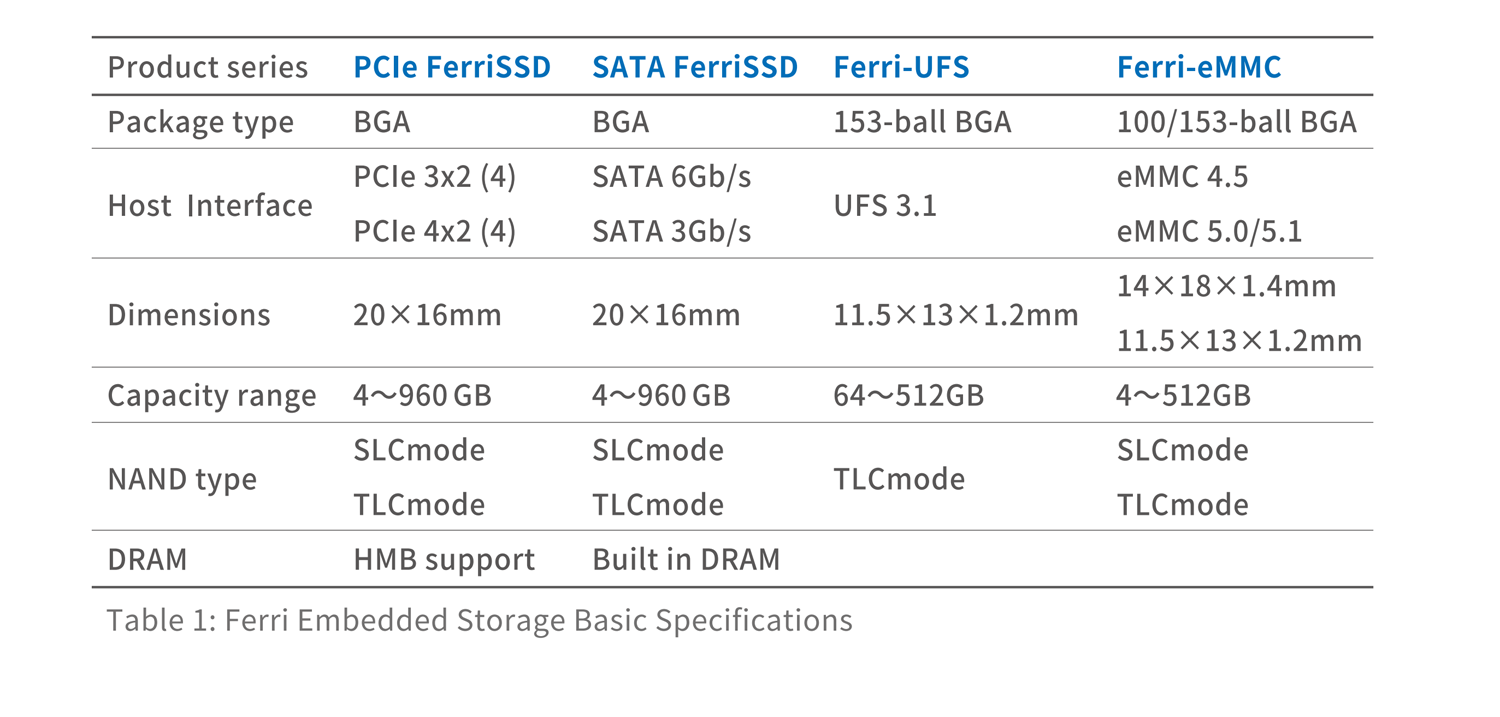
Broad Environmental Tolerance
Solid-state storage devices based on NAND flash memory are inherently shock-resistant because they have no moving parts. Recognizing that write-cycle life and data-storage capacity are greatly affected by the ambient temperature:
• Ferri embedded storage is available in commercial, industrial, and (the most stringent) automotive operating-temperature grades
• FerriSSD is the first among this type of product on the market to integrate heat dissipation to ensure long-term stable operation in the target application environment (table 2)
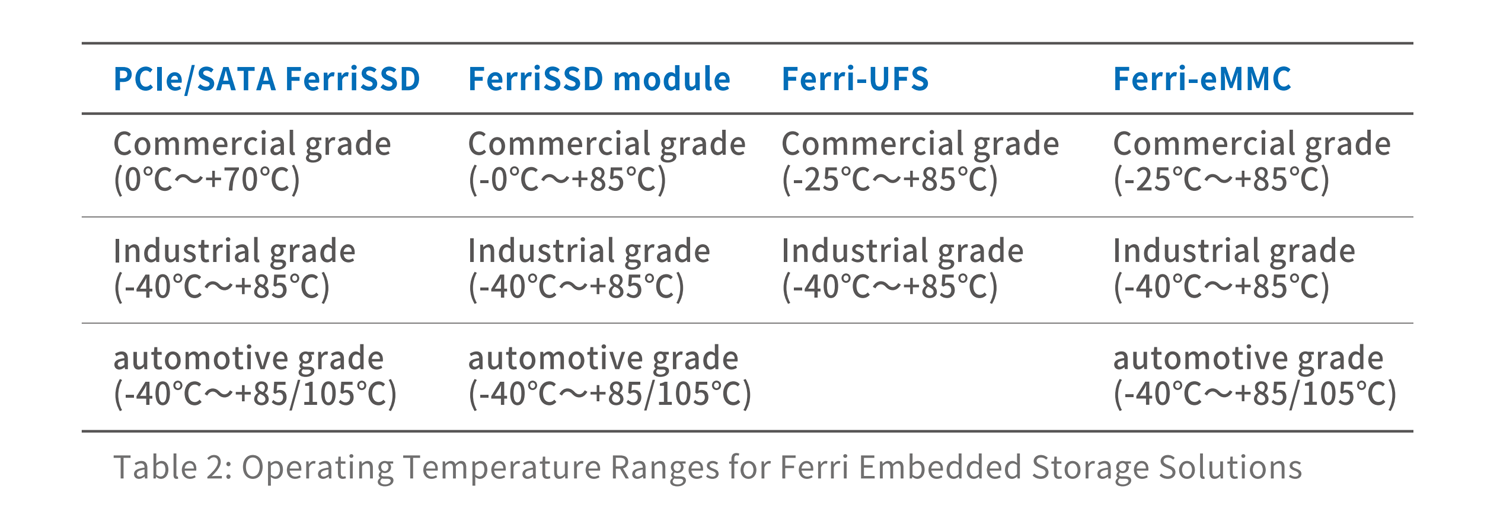
Features for High Reliability
Monitoring systems are typically expected to operate continuously, 365 days, 7 x 24 hours, for an extended lifetime. Accordingly, Ferri embedded storage provides several features to maximize reliability and ensure stable long-term operation. Each series also features technology-specific high-reliability mechanisms to minimize the potential failure risks of NAND flash storage devices at different stages of the lifecycle.
Failure Risk in Early Life
• Comprehensive testing measures that are unique to Silicon Motion are applied at the time of manufacture
• Tests carried out during production perform high- and low-temperature detection on each unit, page, and block of NAND memory
• All Ferri series products are 100% tested to ensure that the products delivered to users satisfy all appropriate specifications
Failure Risk in Mid Life
Exposure to excessive temperatures, power failures, and other hazards during operation can cause transmission bit errors between the host and the storage device, resulting in data loss and permanent damage to memory cells.
To mitigate these risks, FerriSSD provides a variety of features that effectively safeguard the stability and reliability of written data. These include:
• End-to-end data path protection
• Built-in ECC engine
• Intelligent scanning
• Power-Off Protection Mechanism
Mid-Life Protection Features in Detail
End-to-End Data Access Path Protection
End-to-end data access path protection provides full data error detection capabilities through the recovery engine. This safeguard can detect errors in all links in the SSD data access path, from hardware (ASIC), firmware, and NAND Flash memory, to volatile memory including SRAM and DRAM buffer memory. The first and second rows of figure 3 illustrate the reading and writing processes respectively. CRC detection is included, which verifies correct data transmission to guard against data access and transfer process errors.
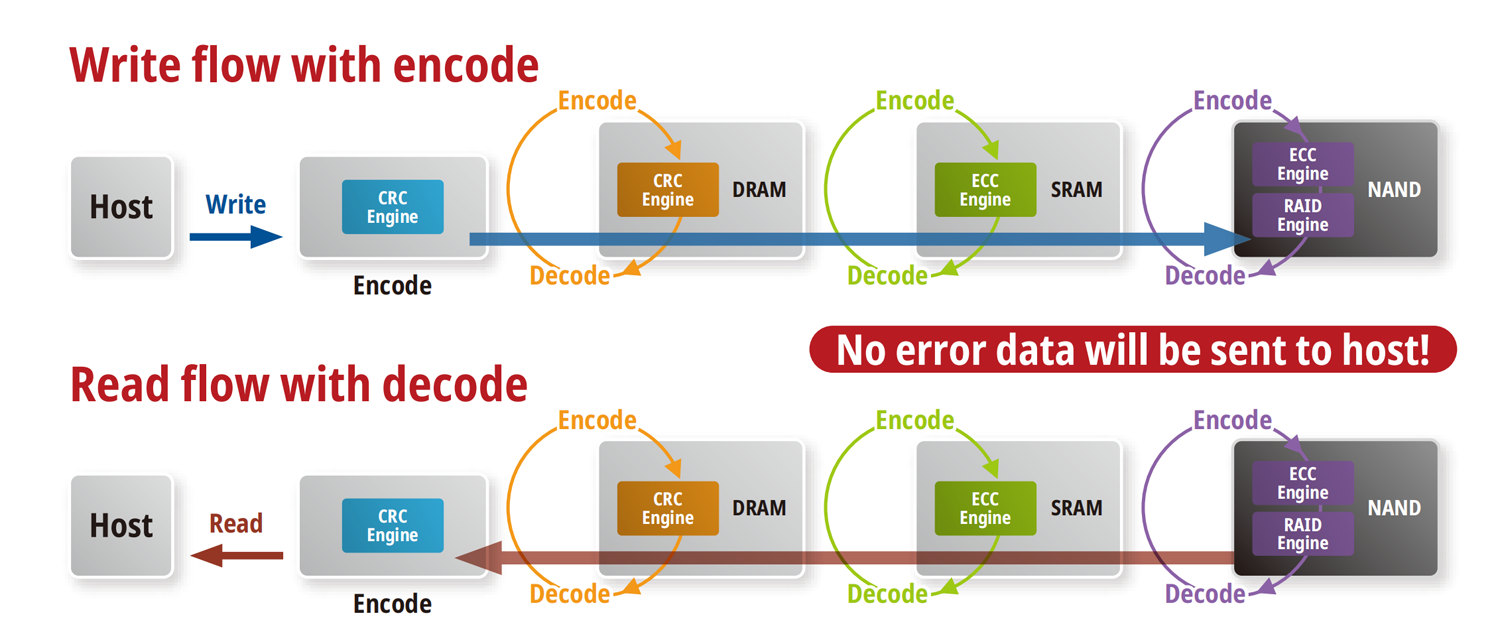
Figure 3: End-to-end data path protection ensures data integrity in Ferri storage
ECC Engine
The built-in ECC engine of Ferri embedded storage products helps correct write errors and extend NAND memory life. Ferri-eMMC contains a BCH ECC engine, while Ferri-UFS features Silicon Motion's fourth-generation LDPC ECC engine.
FerriSSD combines LDPC ECC with a Group Page RAID algorithm implemented by Silicon Motion's NANDXtend® technology. This algorithm corrects for larger 16KB code-word unit errors, providing a second level of protection that ordinary 1KB code-word unit ECC engines used in conventional SSDs cannot offer.
The NANDXtend Group Page RAID algorithm is uniquely suited for low- and medium-density SSDs typically used in boot load applications and extends SSD life expectancy while also significantly reducing lifetime dPPM (figure 4).
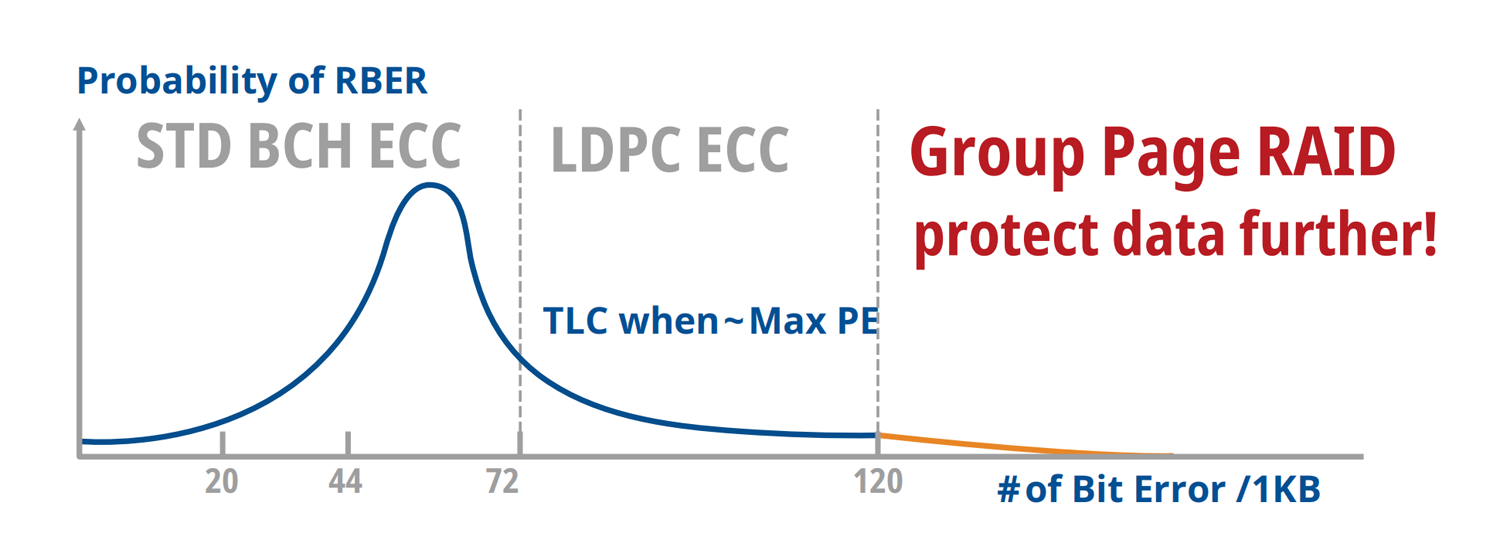
Figure 4. Silicon Motion's NandXtend technology enhances the reliability of surveillance equipment.
IntelligentScan
Ferri's exclusive IntelligentScan function detects the status of NAND memory blocks and cells and works with the DataRefresh function to automatically repair or replace flash memory that is at risk of failure. Together, these two features prevent the problem of reading interference and maintain the reliability and stability of the overall storage device.
IntelligentScan is automatically activated according to the host access behavior or if changes are detected in the working environment, such as rising ambient temperature. It can work with the built-in temperature sensor of FerriSSD devices and automatically increases the scanning frequency if it detects an increase in operating temperature, to minimize the probability of access errors .
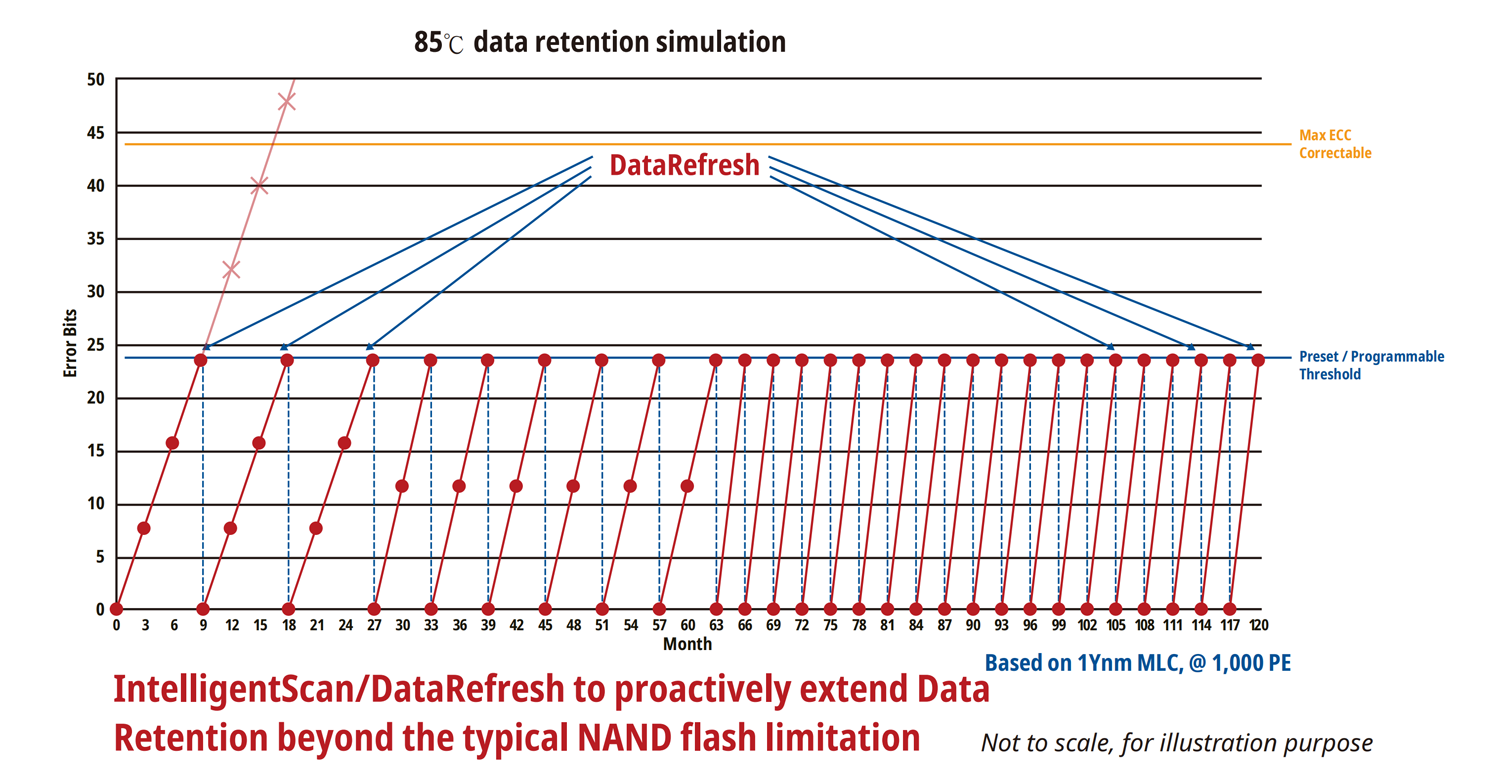
Figure 5. IntelligentScan ensures reliable data retention for the lifetime of the storage device.
Power-Off Protection Mechanism
In addition, Ferri-UFS and Ferri-eMMC both provide PowerShield and DataPhoenix technologies, which can respond to the possibility of data damage due to power failure.
Ferri embedded storage also includes Silicon Motion's FastWrite technology, which accelerates the writing speed of specific areas when the power is turned off and writes DRAM data into NAND memory. This reduces the demand for UPS capacity and minimizes the impact of power outages.
Risk of Failure in End-Of-Life Stages
The lifetime of NAND flash memory is known to limited by the number of write-erase cycles and may malfunction when this limit is reached. Ferri embedded storage products feature Silicon Motion's advanced Global Wear Leveling technology, which distributes write and erase actions evenly among all NAND memory cells to prolong the life of the memory
Conclusion:
Silicon Motion's Ferri embedded storage portfolio contains an extensive selection of products that are suitable for digital surveillance applications. In particular, FerriSSD allows an extremely small deployment footprint, offers diverse interface and capacity options as well as various operating-temperature grades, and integrates a comprehensive set of advanced features for high-reliability design.
Moreover, Silicon Motion supports the Ferri embedded storage portfolio by providing customized services that can be tailored to meet the special needs of users.